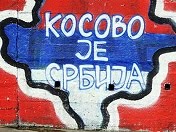Abonați-vă la:
Postare comentarii
(
Atom
)
Citate din gândirea profundă a europeiştilor RO
Andrei Marga, 1995 ("Filosofia Unificării Europene"): "Identificările etnice ale românilor sunt în mare parte tradiţionale. Acestea caută să abată atenţia de la problemele concrete ale prezentului şi de la nevoia modernizării instituţionale spre abstracţiunile trecutului. Pentru mulţi intelectuali este limpede că naţionalismul, prin demagogia sa, generează stagnarea şi degradarea ce favorizează doar grupuri sociale incapabile să se adapteze lumii moderne. Intrarea în noua Europă, nu doar geografic, ci şi instituţional şi cultural presupune mai mult decât o alegere, presupune o schimbare a modului de gândire, de asumare, pe lângă devizele paneuropene, a unei abordări europene, o abordare disponibilă la compararea performanţelor, orientată spre modernizare şi având ca perspectivă unitatea europeană".
Postări populare:
-
- S-a ivit holera-n ţară şi Busuioc nu vrea să ştie de ea! Stăpânirea opreşte oamenii să mai vină la lucru. Au dat de ştire cu toba prin sat...
-
Nu că n-ar putea fi mâna organizaţiei Illuminati ("Les Illuminés") ; dar în limba franceză - care are multe subtilităţi -, "...
-
Ori sunt praf (organizaţional), ori sabotajul este extins la nivele înalte. Pâi cum să "pleci mai departe" - două din trei elico...
-
Într-un articol din Gândul, scrie aşa: "Elevii vor fi vaccinaţi cu Cantgrip pentru imunizare împotriva virusului AH1N1, responsabil ...
-
Curtea Constituţională a respins legea interceptărilor ("Big Brother") cu majoritate de voturi, nu în unanimitate - ceea ce mă ...
-
În timp ce posibilităţile capitalului românesc se rezumă în evazionarea fiscalizării profitului la neînregistrări în acte şi artificii co...
-
Traducerea articolului "The Communist-Capitalist Alliance", apărut la Radio Liberty. partea a doua partea a treia Parte...
-
Polémia : Les funérailles de Charb et de Stéphane Charbonnier Frédéric Malaval, philosophe, écologiste, essayiste… ♦ Le vendred...
-
Nu-i clar dacă şi "operatorii" sunt complici, ori dacă îşi dau seama despre implicaţii. Atenţie de ce instituţii aparţin ei, poate...



























Un comentariu :
Dacă atacul era copleşitor sau prin surprindere, nici nu trebuiau "alte arme" (deşi câte un pistol sau revolver, n-ar fi stricat):
Arditi soldiers were encouraged not to carry their long carbine rifles. Instead, they were armed with a distinctive dagger and a pair of hand grenades.
They preferred the Thevenot hand grenade, as it provided a limited, somewhat weak explosion, contrary to the noise it made once activated. This caused terrible confusion among the entrenched enemy soldiers, who had been dazed by the artillery barrage.
For attacks against bunkers and pillboxes, the Arditi used flamethrowers and small-calibre infantry cannons which were easy to carry. Their main weapon, however, which made them notorious among enemy troops, was the dagger.
Highly-skilled in hand-to-hand combat, the Italian commandos would jump into an enemy trench and massacre everyone inside.
Even though it would seem this tactic was out-dated at the time of WWI, it proved to be most effective. Standard-issue infantry weapons were often long bolt-action rifles, which were of little use in direct fighting.
The men were trained along the lines of a fencing and martial arts manual, entitled The Flower of Battle, written in the late 14th century, by a knight called Fiore dei Liberi. This gave them an advantage in close combat which proved to be crucial for their success.
Driven by the motto “We either win, or we all die,” the Italian shock troopers carried out suicide charges. Their casualties were 25% to 30% on each mission. On one occasion, while attacking Monte Osvaldo in April 1916, an entire Arditi unit comprised of 13 officers and 400 soldiers was completely wiped out.
Although their success rate was favorable, it was an incredibly dangerous calling.
In 1917, there were 18,000 Arditi members. A training facility was established at Sdricca di Manzano, in the region of Friuli. By the end of the war, there were 25 assault units, forming a division of shock troopers.
https://www.warhistoryonline.com/world-war-i/elite-italian-shock-troops-arditi-either-win-die.html
Trimiteți un comentariu